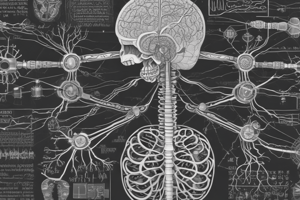Podcast
Questions and Answers
What is the normal pH range for blood?
What is the normal pH range for blood?
- 8.35-8.55
- 7.35-7.45 (correct)
- 6.80-7.00
- 7.70-8.00
What is a heavy metal normally found in the body?
What is a heavy metal normally found in the body?
- Lead
- Iron (correct)
- Mercury
- Arsenic
Sucrose is a _____.
Sucrose is a _____.
- Disaccharide (correct)
- Polysaccharide
- Triglyceride
- Monosaccharide
Neutral fats have a ________ ratio of fatty acids to glycerol.
Neutral fats have a ________ ratio of fatty acids to glycerol.
In a DNA molecule, the phosphate serves ___.
In a DNA molecule, the phosphate serves ___.
Most fibrous proteins in the body contain all of these except:
Most fibrous proteins in the body contain all of these except:
Heat shock proteins (Hsp) are a type of protein called ________.
Heat shock proteins (Hsp) are a type of protein called ________.
______ bonds often bind different parts of a molecule into a specific 3-dimensional shape.
______ bonds often bind different parts of a molecule into a specific 3-dimensional shape.
Flashcards are hidden until you start studying
Study Notes
Nervous System and Chemical Processes
- Sodium (Na) is essential for the proper conduction of nervous impulses.
- Phospholipids are partially polar and partially non-polar in nature, playing a critical role in cell membranes.
- Genetic information is encoded in DNA through the sequence of nucleotides.
Proteins and Their Functions
- Proteins can be denatured by heat or acidity; their function relies on their three-dimensional shapes.
- Collagen is the most abundant protein in the body, providing structural support.
- Enzymes, which are proteins, function as biological catalysts, but they do not carry genetic information.
Carbohydrates and Energy Storage
- Carbohydrates are stored in the body as glycogen, primarily in the liver and muscles.
- Neutral fats consist of a 3:1 ratio of fatty acids to glycerol.
Enzymes and Reactions
- Coenzymes are organic molecules derived from vitamins, enhancing enzyme activity.
- Chemical reaction speed is influenced by temperature, concentration, and catalysts but not by the mere presence of carbon.
- In redox reactions, both decomposition and electron exchange occur; the electron acceptor is oxidized, while the donor is reduced.
Acids, Bases, and pH
- A pH of 2 indicates a highly acidic solution.
- Human blood typically maintains a pH range of 7.35 to 7.45.
Elements and Isotopes
- The four elements making up roughly 96% of the body are carbon, oxygen, hydrogen, and nitrogen.
- Isotopes differ in atomic mass but have the same atomic number and exhibit varying neutron counts.
Molecular Structures
- Chemical bonds determine molecular stability, with hydrogen bonds influencing the three-dimensional structures of proteins and nucleic acids.
- The formula C6H12O6 represents a molecule with 6 carbon, 12 hydrogen, and 6 oxygen atoms, indicating a glucose structure.
Types of Solutions
- Blood is an example of a suspension, while colloids are mixtures that do not settle but scatter light.
- Solutions consist of a solvent in larger quantities and solute in smaller amounts.
Fat-Soluble Vitamins
- Vitamin D is produced in the skin upon UV exposure and is crucial for bone growth.
Amino Acids and Proteins
- A polypeptide chain consists of 25 amino acids.
- Fibrous proteins like collagen and elastin are vitamin-derived and generally insoluble in water.
Chemical Reactions and Synthesis
- Amino acid bonds reflect synthesis reactions, whereas time does not influence reaction rates significantly.
- Dipeptides form by the condensation of amino acids.
Unique Molecular Characteristics
- Dipoles are polar molecules characterized by unequal sharing of electrons.
- The presence of an unaccounted ion results in the creation of an anion when ionically bonded.
Colloids and Mixtures
- Examples of colloids include Jell-O and cytosol, both demonstrating scattering properties.
- Colloids differ from true solutions due to visible scattering and the absence of sedimentation.
Minerals and Heavy Metals
- Iron is recognized as a heavy metal naturally found in the body, integral for various biological processes.
- Water (H2O) is not considered an electrolyte, despite being vital for life.
Studying That Suits You
Use AI to generate personalized quizzes and flashcards to suit your learning preferences.




